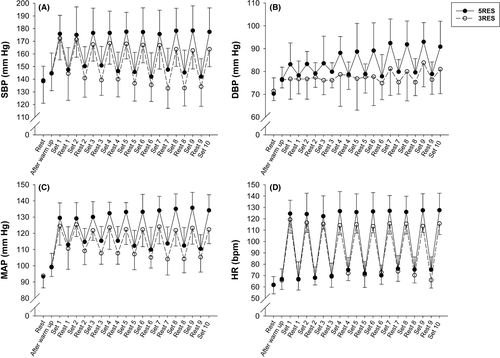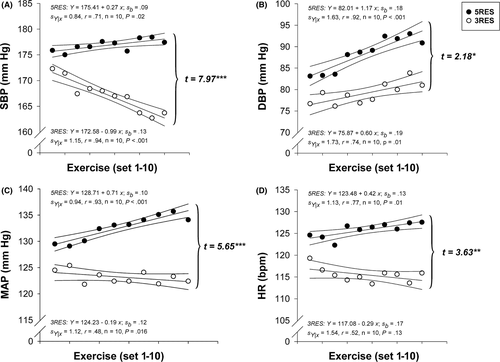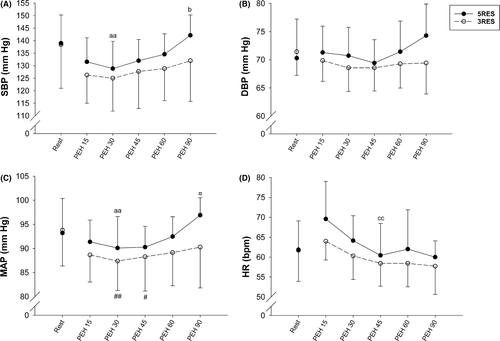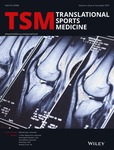Intra-arterial blood pressure traits during and after heavy resistance exercise in healthy males
[The copyright line for this article was changed on 12 November 2019 after original online publication.]
Abstract
This randomized within-subjects crossover-designed study evaluated intra-arterial blood pressure (BP) traits in seven healthy males (24 ± 1 years) during heavy resistance exercise (HRE) to failure (10 × 5 repetitions, 5RES) and not to failure (10 × 3 repetitions, 3RES), both at 5RM load. By combining few repetitions, avoidance of Valsalva maneuver, and restricting the duration of each contraction, we hypothesized (a) that HRE could be performed without acute excessive elevated BP; (b) a dose relationship regarding acute BP elevation following 5RES versus 3RES; and (c) both modes of HRE to induce post-exercise hypotension (PEH). BP was measured before, during, and throughout 90 minutes post-exercise. Systolic BP and mean arterial pressure decreased during 3RES (P < .001 and P < .05) and increased during 5RES (P < .01 and P < .001). The maximal individual systolic BP observed during exercise was 191 (3RES) and 212 mm Hg (5RES). Both modes of HRE induced PEH with lower systolic and mean arterial pressure (both P < .01). Documented by continuous intra-arterial BP monitoring, this study demonstrates that HRE can be performed without acute excessive elevated BP during exercise, but still induce PEH. These novel results are important, as they may pave way for future studies utilizing HRE in patients where avoidance of excessive elevated BP is important.
1 INTRODUCTION
Cardiovascular diseases are responsible for one third of global mortality, accounting for approximately 17 million deaths each year.1 Hypertension is a major risk factor associated with the development of cardiovascular diseases.1, 2 Approximately 40% of individuals above the age of 25 are diagnosed with hypertension worldwide,1 and thus, actions for lowering high blood pressure (BP) are of great importance.
Hypertension may be modified, or even normalized, by non-pharmacological treatments.3 In addition to aerobic exercise as a well-established and recommended treatment of hypertension,4, 5 resistance exercise (RE) has been recommended as a supplement due to its favorable adaptations in musculoskeletal function and in cardiometabolic risk factors.4, 6, 7 However, the studies of the influence of RE on resting BP are limited and conflicting,8 and additional research to expand the limited data on the BP-lowering effect of RE is needed.5
International recommendations do not advise heavy resistance exercise (HRE, >80% 1RM) for patients suffering from hypertension.4, 7 This carefulness may be influenced by earlier studies, which observed extremely high BP acutely during HRE.9, 10 However, no association was reported between the %1RM weight lifted and acute BP values during HRE, if the Valsalva maneuver was avoided.11 The Valsalva maneuver involves closing the glottis after inspiration, followed by an expiratory effort.10 It seems that short rest periods and more repetitions (reps) are important factors for the magnitude of acute increase in BP during RE.11-14 In addition, an increased isometric component when the duration of the contraction is prolonged, which influences the larger arteries, may also contribute to an acute increase in BP during RE.13
The favorable post-exercise hypotension (PEH), following both aerobic exercise and RE, may last for several hours.15 Post-exercise hypotension reflects reduction in both stroke volume and peripheral vascular resistance,16-18 and may be influenced by both the volume and the intensity of RE,19-22 as well as the mass of the working muscle.23 It is shown that a single resistance exercise may induce systolic PEH, if the amount of working muscle mass and number of sets are sufficient.22
If HRE could be performed without excessive elevated BP during exercise, but still induce the favorable PEH, it could be of great importance in both healthy and diseased populations. Therefore, the purpose of this study was to evaluate BP continuously by intra-arterial measurements in healthy males during ten sets of maximal and submaximal HRE at a five-repetition maximum load (5RM, ie, 85% 1RM) and for 90 minutes of rest post-exercise. By utilizing a novel protocol combining (a) few-repetition HRE, (b) avoidance of the Valsalva maneuver, and (c) restriction of the total duration and isometric component of each contraction, we hypothesized that HRE with 10 sets of 3 and 5 reps, respectively, could be performed without excessive elevations in BP during exercise. Furthermore, we expected a dose relationship with respect to the magnitude of BP elevation, and lastly, we expected both HRE modes to induce PEH.
2 MATERIALS AND METHODS
We conducted a randomized, within-subjects crossover design study. The subjects underwent two different modes of exercise: (a) a five-repetition exercise session (5RES) and (b) a three-repetition exercise session (3RES) in a random order. Upon arrival at the laboratory, the subjects were informed about which of the sessions to perform. There was a ≥48-hour washout period between the sessions. The BP, heart rate (HR), and the blood lactate concentration (cBLa) were measured before and during exercise, as well as 90 minutes post-exercise. To reduce bias, three sessions were carried out prior to the study sessions to be sure the subjects were familiarized with the test protocols.
2.1 Subjects
Nine healthy and normotensive male students volunteered to participate in this study after local announcement. Seven of the subjects completed the whole study (Table 1), while two withdraw their consent. The subject's experience with resistance training did vary; however, all subjects were familiar with physical training as they were either a university college student in sports science, or an athlete at the university college football team. All subjects were considered healthy due to a clinical examination containing electrocardiography, blood samples, screening of medical history, and assessment of BP, conducted by a specialist in internal medicine and cardiology.
| Variables | |
|---|---|
| Age (y) | 24 ± 1 |
| Height (cm) | 180 ± 8 |
| Body mass (kg) | 80 ± 14 |
| 5RM (kg) | 179 ± 21 |
| SBPa rest, cuff (mm Hg) | 124 ± 10 |
| SBPa rest, intra-arterial (mm Hg) | 139 ± 14 |
| DBPa rest, cuff (mm Hg) | 69 ± 9 |
| DBPa rest, intra-arterial (mm Hg) | 71 ± 6 |
| HRa rest (bpm) | 62 ± 7 |
| cBLaa rest (mmol/L) | 0.9 ± 0.2 |
- Abbreviations: 5RM, 5-repetition maximum in the leg-press apparatus; bpm, beats per minute.
- a Systolic blood pressure (SBP), diastolic blood pressure (DBP), heart rate (HR), and blood lactate concentration (cBLa) are presented as an average from the resting measurements conducted after the cannulating of the artery, before each of the two exercise sessions (3RES and 5RES).
This study was approved by the regional committee for medical and health research ethics and was conducted according to the 2nd Declaration of Helsinki. All subjects were fully informed about the procedures and potential risks before signing a written informed consent. It was explicitly stated to the subjects that they could withdraw from the study at any point. Further methodological details are given in the supplementary section.
3 RESULTS
Figure 1 (A-D) shows the traits for SBP, DBP, MAP, and HR from rest and during 10 sets of HRE by 3RES and 5RES, respectively. During rest and after warm-up, there were no significant differences in any of the measured variables between the two exercise modes (Table 2). Mean DBP and MAP during exercise, as mean of the work periods related to the 10 sets of HRE, were significantly lower during 3RES compared with 5RES, DBP 11.6% (Cohen's d = 0.88, large effect) and MAP 7.6% (d = 1.04, large effect) (Table 2). Similarly, mean SBP and HR during exercise were 5.8% (d = 0.62, medium effect) and 8.9% (d = 0.87, large effect) lower during 3RES compared with 5RES. However, these latter differences were not statistically significant. The average of the individual peak values for DBP, MAP, and HR during the 10 exercise sets was significantly 8.2% (d = 0.80, large effect), 5.7% (d = 0.85, large effect), and 10.1% (d = 0.93, large effect) lower during 3RES compared with 5RES, respectively (Table 2). The highest individual SBP observed during exercise for 3RES and 5RES was 191 mm Hg and 212 mm Hg, respectively. The average peak SBP during exercise did not differ between exercise modes (d = 0.41, small effect). The cBLa was 2.3 times higher for 5RES after the end of the exercise session compared with 3RES (P < .01; d = 1.90, large effect).

| Variables | 3RES | 5RES | P-value | Cohens' d |
|---|---|---|---|---|
| SBPREST (mm Hg) | 138 ± 17 | 139 ± 11 | n.s. | 0.04 |
| SBPPOST-WARM-UP (mm Hg) | 145 ± 14 | 145 ± 16 | n.s. | 0.01 |
| SBPMEAN EXERCISE (mm Hg) | 167 ± 14 | 177 ± 17 | .08 | 0.62 |
| SBPPEAK EXERCISE (mm Hg) | 178 ± 16 | 184 ± 17 | n.s. | 0.41 |
| DBPREST (mm Hg) | 71 ± 4 | 70 ± 7 | n.s. | 0.19 |
| DBPPOST-WARM-UP (mm Hg) | 76 ± 4 | 77 ± 5 | n.s. | 0.07 |
| DBPMEAN EXERCISE (mm Hg) | 79 ± 11 | 88 ± 10 | .006 | 0.88 |
| DBPPEAK EXERCISE (mm Hg) | 88 ± 8 | 95 ± 10 | .02 | 0.80 |
| MAPREST (mm Hg) | 94 ± 7 | 93 ± 7 | n.s. | 0.08 |
| MAPPOST-WARM-UP (mm Hg) | 110 ± 8 | 111 ± 10 | n.s. | 0.02 |
| MAPMEAN EXERCISE (mm Hg) | 123 ± 9 | 133 ± 9 | .02 | 1.04 |
| MAPPEAK EXERCISE (mm Hg) | 131 ± 10 | 138 ± 8 | .05 | 0.85 |
| HRREST (bpm) | 62 ± 8 | 62 ± 7 | n.s. | 0.03 |
| HRPOST-WARM-UP (bpm) | 66 ± 8 | 67 ± 9 | n.s. | 0.12 |
| HRMEAN EXERCISE (bpm) | 116 ± 8 | 126 ± 15 | .07 | 0.87 |
| HRPEAK EXERCISE (bpm) | 116 ± 10 | 128 ± 15 | .01 | 0.93 |
| cBLaREST (mmol/L) | 0.9 ± 0.2 | 0.9 ± 0.3 | n.s. | 0.00 |
| cBLa POST-WARM-UP (mmol/L) | 1.1 ± 0.3 | 1.2 ± 0.7 | n.s. | 0.19 |
| cBLaAFTER EXERCISEa (mmol/L) | 1.3 ± 0.4 | 3.0 ± 1.2 | .006 | 1.90 |
- Abbreviations: bpm, beats per minute; cBLa, blood lactate concentration; DBP, diastolic blood pressure; HR, heart rate; MAP, mean arterial pressure; PEAK EXERCISE, average of each individual peak values during work periods; MEAN EXERCISE, mean of the work periods in the ten exercise sets; POST-WARM-UP, resting before first set; REST, resting before warm-up; SBP, systolic blood pressure;
- a AFTER EXERCISE, immediately after 10 sets.
Figure 2 (A-D) shows the regression lines for SBP, DBP, MAP, and HR during the 10 sets of HRE for both exercise modes. In short, SBP and MAP decreased during work periods in 3RES, but increased for 5RES, with a significant difference in the slopes of the regression lines between the two modes. Diastolic Blood Pressure increased more during exercise for 5RES than for 3RES. For HR, there was a significant increase during exercise for 5RES, while 3RES was unchanged; the slopes of the regression lines for HR were significantly different between the two modes.

In Figure 3 (A-D) and Table 3, the post-exercise response for SBP, DBP, MAP, and HR for 3RES and 5RES is presented. For SBP, there was a significant main effect of time with SBP 9.3% lower at 30 minutes post-exercise compared with rest (d = 0.91, large effect) and 8.0% higher at 90 minutes post-exercise compared with 30 minutes post-exercise (d = 0.80, large effect). There was no significant main effect of exercise and no significant interaction of time by exercise condition upon SBP in the post-exercise period. For DBP, there were no main effects of neither time nor exercise, and no significant interaction of time by exercise. For MAP, there was a significant main effect of time with 5.3% lower MAP 30 minutes post-exercise compared with rest (d = 0.71, moderate effect). The main effect of exercise was not significant, but the interaction effect of time by exercise approached significance. The 3RES had significant 7.3% and 6.2% lower MAP at 30 minutes and 45 minutes (d = 0.94, large effect; 0.75, moderate effect, respectively) post-exercise as compared to rest. By 5RES, MAP was 7.3% higher at 90 minutes post-exercise compared with 45 minutes (d = 1.67, large effect). HR post-exercise showed a significant main effect of time with 12.4% lower HR 45 minutes post-exercise compared with 15 minutes post-exercise (d = 1.01, large effect). The main effect of exercise on HR was not significant, and neither was the interaction of time by exercise. In rest before and after exercise, SBP monitored intra-arterially showed higher values at all time points compared with the noninvasive BP measurements. Overall, the intra-arterial SBP measurements were 9% compared with the noninvasive (130 mm Hg vs. 119 mm Hg, respectively; P = .04).

| Variables | Main effect of time | Main effect of exercise | Interaction time × exercise |
|---|---|---|---|
| SBP | F5/30 = 13.63***, pη2 = 0.69 | F1/6 = 0.73, pη2 = 0.11 | F5/30 = 2.17, pη2 = 0.27 |
| DBP | F5/30 = 1.52, pη2 = 0.20 | F1/6 = 0.36, pη2 = 0.06 | F5/30 = 1.64, pη2 = 0.22 |
| MAP | F5/30 = 6.61***, pη2 = 0.52 | F1/6 = 0.62, pη2 = 0.09 | F5/30 = 2.63*, pη2 = 0.30 |
| HR | F5/30 = 5.67***, pη2 = 0.49 | F1/6 = 1.95, pη2 = 0.25 | F5/30 = 0.61, pη2 = 0.09 |
Note
- The table presents repeated measures ANOVA for 3-repetition exercise session (3RES) and 5-repetition exercise session (5RES) combined.
- Abbreviations: SBP, systolic blood pressure; DBP, diastolic blood pressure; MAP, mean arterial pressure; HR, heart rate; F, The nominator and denominator for degrees of freedom and the corresponding F-score; pη2, partial eta-squared.
- * P ≤ .05.
- *** P ≤ .001.
4 DISCUSSION
In the present study, the acute BP traits during and for 90 minutes post-exercise for two modes of HRE were evaluated. The main findings were as follows: (a) HRE with few repetitions could be performed without acute excessive elevation of BP during exercise, but BP increased more with 5-repetition exercise session (5RES) compared with 3-repetition exercise session (3RES). (b) Both modes of HRE (3RES and 5RES) induced systolic and mean arterial post-exercise hypotension. These findings obtained by continuous monitoring of intra-arterial BP constitute novel and reliable results of great importance, as they may form basis for future studies utilizing HRE as medicine in patients where it is important to avoid excessive elevation of blood pressure.
4.1 Blood pressure during HRE
The modest increase in BP during exercise by both modes of HRE demonstrates that HRE can be performed without acute excessive elevation of BP. International guidelines for exercise training recommend termination of exercise if SBP >250 mm Hg or DBP >115 mm Hg.26 Thus, both 3RES and 5RES as utilized in this study could be a safe way to perform HRE. The importance of the presented finding is strengthened by the fact that HRE has been shown to positively influence both musculoskeletal function (eg, strength, mass, and power) and the cardiometabolic risk factors (eg, insulin sensitivity, glucose intolerance, dyslipidemia, and hypertension).6 Compared to 3RES, the 5RES protocol would probably have the potential to elicit even greater musculoskeletal and metabolic alterations due to higher volume and acute metabolic demands during exercise.27 However, as we did not investigate the differences between the two modes of exercise, the difference between modes remains speculative.
The lack of acute excessive elevation of BP during HRE may be due to short time of mechanical compression of the blood vessels in our exercise protocol. However, the higher BP dose relationship with higher BP in 5RES compared to 3RES may be due to higher grade of compression of the blood vessels. Our findings are in line with recent studies indicating progressive elevation of BP for each repetition in a set.13, 14 The total mechanical compression of the blood vessels may be amplified by the duration of the set, number of reps, or length of work period, and may further trigger the sympathetic nervous system,13 and lead to higher cardiac output and total vascular peripheral resistance, both increasing BP during HRE.10
To avoid excessive sympathetic nerve activity, due to mechanical compression of the vessels, a protocol with few reps with short duration was utilized in the present study. The results in our study are supported by several studies 11, 13, 28 which also have demonstrated that HRE with few reps and high resistance could be performed without acute excessive elevations in BP. However, some of these studies assessed the BP noninvasively with the possibility of missing the peak BP,11, 28 while others measured the BP intra-arterial during HRE with reps to failure,13 but contrary to the present study, there was no comparison of submaximal and maximal HRE at similar intensity. The presented results demonstrate that the number of reps is a major factor for the acute BP response during HRE. Even though there is a dose relationship, avoiding reps until failure may be an easy way to avoid acute excessive BP elevation. However, as we did not include longer reps duration or reps until failure in the present study, the extent to which these factors contributed to acute BP during exercise remains speculative.
Older studies 9, 29 have demonstrated that BP may increase with augmented intensity during HRE. Narloch, Brandstater 10 demonstrated the importance of avoidance of the Valsalva maneuver. They reported SBP above 300 mm Hg during HRE 100% 1RM utilizing the Valsalva maneuver compared with 200 mm Hg avoiding the Valsalva maneuver. Furthermore, unintentional use of the Valsalva maneuver with high-intensity HRE may cause elevations in BP.10, 11 In the present study, all exercises were performed with subjects trying to avoid using the Valsalva maneuver. However, as we did not include HRE utilizing the Valsalva maneuver in the present study, the extent to which Valsalva maneuver contributed to acute BP exercise remains speculative. Thus, the difference we observed between 3RES and 5RES may still be influenced by unintentional use of the Valsalva maneuver related to accumulative fatigue by multiple reps.
4.2 Blood pressure after HRE
We found that ten sets of HRE (≤5 reps) in leg-press apparatus can induce systolic PEH, both in 3RES and in 5RES. Our findings are in line with others.22 The PEH response is of great importance, considering that it may be related to lowering BP with reduced need of medications, increase longevity, and reducing the levels of cardiovascular risk factor.19 In line with others, we did not observe any significant difference in DBP post-exercise, which is consistent with the hypothesis that PEH is mainly affecting SBP in normotensive individuals after HRE.5, 22, 30, 31
The magnitude of the systolic PEH observed in the present study is in line with others,18, 22 but also more pronounced compared with others,21, 32 even though our study consisted of HRT with less reps, lower volume, and heavier resistance. This may indicate that the magnitude of resistance during exercise is important. In the present study, the BP was measured for 90 minutes post-exercise, with peak PEH revealed at 30 minutes post-exercise followed by a gradually return toward baseline. Our results are also similar to,33 which demonstrated that a larger exercise volume may cause a prolonged PEH. Some have hypothesized that PEH is caused by a combination of change in stroke volume and HR,18, 30 while others have suggested a relationship of cBLa with systemic vascular resistance.19, 34 However, we observed no difference in HR post-exercise compared with pre-exercise, and no difference in PEH despite a cBLa 2.3 times higher in 5RES compared with 3RES.
4.3 Strengths and limitations
Main strength of the present study is the use of continuously intra-arterial assessment of BP during exercise. As BP and HR were measured as the average of 12 seconds, they are more robust compared to beat-to-beat measurements, but less sensitive to observe the absolute peak BP. The intra-arterial BP was higher compared with the noninvasive BP before and after exercise. This may be due to local vasospasm in the cannulated vessel and/or white-coat hypertension (see Table S1 for individual data). However, due to the crossover design this should not influence the presented difference between modes of exercise. To avoid white-coat hypertension, the subjects underwent three familiarization sessions prior to the study sessions. Despite our precautions, we cannot exclude white-coat hypertension influencing the PEH found in the present study. A second limitation in our study is the lack of measurements of stroke volume and peripheral resistance. A third limitation is the lack of examination of how the Valsalva maneuver and longer reps duration would affect BP during heavy resistance exercise. Thus, the extent to which of these factors may contribute to increased BP during exercise remains speculative. Also, as the international guidelines recommend RE <80% 1RM, including an exercise protocol with 8-12RM would have provided valuable insight into how our protocol differed from current guidelines. Unfortunately, as we did not include that protocol in our study, we cannot tell to what extent our protocol would differ.
In conclusion, heavy resistance exercise could be performed without acute excessive elevation of blood pressure, but still induce the favorable post-exercise hypotension, when performed with few repetitions, avoidance of the Valsalva maneuver, and restriction of the total duration of each contraction. Blood pressure increased during heavy resistance exercise performed to failure, but fell during exercise not to failure with the same weight load.
5 PERSPECTIVES
The combination of few repetitions, contractions with short duration and avoidance of the Valsalva maneuver, is helpful to avoid acute excessive elevation of blood pressure during heavy resistance exercise. The heavy resistance exercise may favorably be performed in several sets and with few repetitions not to failure. Importantly, by manipulating heavy resistance exercise to avoid acute excessive elevated blood pressure, more patients suffering from hypertension or cardiovascular diseases may benefit from the positive physiological alterations of heavy resistance exercise. Thus, heavy resistance exercise can be performed safely, and if confirmed in future clinical studies, several patient groups may benefit from heavy resistance exercise as medicine.
ACKNOWLEDGEMENTS
The authors would like to acknowledge the participants for contributing in this study.




